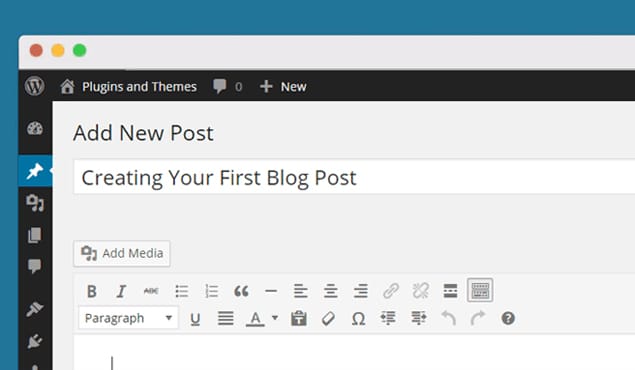You can’t say there’s nothing to read anymore. With the average person’s addiction to Facebook and the incessant feeding of news, entertainment, and random articles your weird uncle decided to share, there is always something to feast your eyes upon.
That feast is often riddled with moving and still images, but around those picturesque snapshots of our modern times are tried and true words.
Words tell a story, explain a concept, and allow us to relate to one another.
That said, the way in which writers use words on the internet today is unique. Sure, yes, there are still literary luminaries penning short stories, there are political correspondents dishing out heart-wrenching war stories, there are data-driven analysts that can’t elicit emotion to save their lives — all these types of writing still exist.
But in the modern context there is the blog, and the blog has now overtaken all those other forms as the most common approach to writing for the internet. Part of that is the format and diction of a blog post, both of which are easier to learn and churn out than the above methods.
Part of it, too, is our culture’s current obsessions to rank high on the viral chart, to garner hundreds of thousands of views and shares. There is a science to this, and the blog gods have laid down the laws in a number of forms.
I’ll break down the types of blog posts one can write and touch on two unique styles in which blogs are published.
Use this as a touchstone when writing your own articles, or as one piece of a fascinating study into why our culture does what it does.
Blog Article Types
I may have mentioned a blog god above — the truth is that there is no set number of blog post types, and there is nothing that keeps people from creating more. In fact, as time goes on different methods of blogging rise and fall, so don’t feel like you have to fit one of these molds to write an article.
That said, below are some of the most common and effective ways to go about organizing your opinion and information.
Numbered Lists
If you’re rolling your eyes, it’s because I’ve started with the most obvious, most notorious kind of article. There are people who absolutely love lists, and there are those who absolutely abhor them.
If you want to read a very detailed, scientific report on why people love lists (even if they consciously abhor them), check out this New Yorker article. It will kind of blow your mind.
Regardless of how you personally feel, you can’t deny that lists are popular. People click on them. In fact, there are 10 Reasons People Click on List Articles More Than Any Other.
See how your brain just perked up, like a dog ready for that spoonful of peanut butter? I’m not going to give it to you. That’s not what this article is about. Sad? Write your own article on why there are that many reasons and ship it off to a publisher, because they’ll probably snap it up.
Lists articles are so popular I need to break them down into two different kind of lists.
The “Best of” Top 10 Lists
“Ten” is not a fixed number here, but a mentality that keeps the magical lists to a reasonable amount. Ten itself is a magical number in that we love to read about 10 perfect things, because it’s even and ends in a place we like, but six and eight and 11 serve the same purpose.
The Top 10 List articles are typically couched in that relatively small number because they are the “best” of those things or the 10 worth writing about. They are not everything on a given topic, but a curated selection by the author for you, the reader.
People love these lists because they’re usually quick to read and easy to identify with. As an example, look at Time’s “Top 10 of Everything 2015” article, and you’ll get the picture.
Comprehensive Lists
The other side of the coin are the comprehensive lists, which are gnarly and endless. Take, for example, the legendary list article by Brian Dean, “Google’s 200 Ranking Factors: The Complete List“.
These lists are still incredibly popular, but for a very different audience. Depending on your topic such lists can be used as a legitimate point of research. In the example listed above, people learning how to rank in Google will commonly bookmark the article and refer to it when strategizing for a website launch.
The long list also demands a certain authority in the topic. If you or your publisher is already seen as a strong voice in a niche, publishing such an article can help to reinforce your dominance in said niche, and it can also make your whole site a stronger resource.
Lastly, the comprehensive list typically ranks better in Google’s search engines. If you end up reading Dean’s article, you’ll find that one of the best ways to rank on Google is through backlinks. Comprehensive lists are typically backlinked more often, because they are typically more authoritative.
How Do I and How To — The Tutorial
Here are some examples:
- How do I find my iPhone?
- How do I get home?
- How do I get a passport?
- How do I register to vote?
These are the four most popular query searches in Google based on the “how do I” prompt, and they are telling. People don’t know how to find stuff, and people need to take a civics lesson.
This category of articles is information explained in order to tackle a problem.
How Do I and How To tutorials are typically in-depth articles on a very specific process, like figuring out how to register to vote, or how to make your own garden bed. This is perfect for niche bloggers because there are countless curious individuals who need to know how to do something, and if you have a great article on that something, they will come a-knocking.
The best ways to write an excellent how to or how do I article are:
- Include step-by-step instructions from beginning to end.
- Include pictures.
- Include the date, if this is a time-based procedure or something that changes over time.
- Include how and why you’re an expert in this particular subject.
- Include linked references to what you’re talking about.
Doing these things will assure the reader you are legitimate, and will actually help them through the process.
“Why” Articles That Answer Questions
This is a broader category, because many articles answer questions — they are treasure troves of information, after all.
The specificity here is the mentality behind a “why” article. Typically these can be scientific in nature, because people are looking for a legitimate resource to answer a why question. They are also usually written by verified experts in fields of study, the kind of people that have a very authoritative reason for why something is the way it is.
This extends beyond science, into politics, philosophy, psychology and all manner of study.
Why articles are not as heavily read as some of others on this list, but, when researched, written well and backlinked properly, they can be a continual method traffic for your site. Exactly like that New Yorker article I referenced earlier, which explains why numbered lists are so effective.
Reviews
A tried-and-true blog post if I ever saw one: the review.
Reviews are one of the most popular and searched categories of articles because they take a real life product and (theoretically) run it through its paces. They compare the product to others in the market, show pictures of that product, and generally tell the consumer whether or not they should go about getting one.
If you’re looking to do a review article, I’d say go for it. However, keep a few things in mind:
- If you review the product, make it impartial. No free gear in exchange for a good review. That’s illegal.
- State clearly on the review how you received the product. Did you buy it? Did you get it for free?
- Include lots of pictures.
- Break up your review into different categories for easy scrolling.
These are the basics when reviewing a product. Also, remember that with the power of the written word you can ask for things. Ping the manufacturer of the product to see if they’ll supply a review unit — no need to break the bank.
Just stand by your guns when it comes to impartial reviewing.
Expert Roundup Posts
The expert roundup blog article is an interesting creature in that it takes articles already written and conglomerates them into one handy post for a reader.
This is usually done in two ways: either you assemble other expert articles and link out to them, or you summarize a collection of posts you have written in a single roundup.
Roundups by nature fall into the recycled content category, in that you aren’t technically creating anything new. This isn’t a problem as long as you do it tastefully, cite your sources and be clear with the reader that there are full articles you are rounding up.
Other Experts
This type of roundup typically involves selecting a topic, gathering 5-25 articles on said topic, and creating your own “expert roundup post” in which you list each of these articles with summaries.
You’ll want to be very clear about who the authors are and provide dofollow backlinks to their articles. This will boost their rankings while providing a valuable resource for your readers.
Sometimes the truth of the matter is that you can’t say something more revolutionary than someone in your field has — sometimes multiple people. This is the time to do an expert roundup post, and point your readers in the right direction.
Sometimes they will click to those other articles, but most of the time they’ll take your summaries and explore the rest of your site.
Your Posts
This is mostly for news-y sites that publish a lot of content. One good example is GearJunkie, who posts a weekly roundup of its most popular posts that week.
This allows readers to stay on top of your general article trends without having to read each article, or peruse your site extensively.
You can also do a roundup of your posts over a longer period of time in a select category. If, for example, you post a recipe a week for your baking blog, consider doing a roundup every year of all your recipes. You don’t have to include every full article, but rather a picture of the food with the recipe overlaid, and a small paragraph.
This recycling of content works wonders to build internal links on your site and infuse a fresh look on your social media accounts.
Infographics
Ah, the infographic. People love this almost as much as lists. Clearly you’ll need to go about creating an infographic to write a post on one, but do consider it, because it has viral potential, is informative, and allows you to get creative with your design.
An infographic article typically doesn’t have too many written words, unless you want to break down each fact of the infographic. If you do that, cite your sources and keep it entertaining.
Also, remember to make your infographic embeddable for easy sharing.
Interviews
If your niche has some stand-out personas that people would like to hear from, get an interview with them.
You can record the interview and post both the audio and transcript online, or you can type up the interview in the context of an article.
Either way will guarantee that readers come to your site, because that person or company you interviewed will draw them like a moth to flame.
Guest Posts
One of the more effective ways to get backlinks, guest posts are the bread and butter of many famous bloggers. You can write guest posts for others, or allow guest posts on your site.
There’s a lot to say about this, and it happens to be Guestpost.com’s speciality — if you didn’t already know.
Make sure you brush up on guest blogging best practices. It’s important you know the history of guest posting and how it’s done effectively.
Styles
Beyond the actual types of posts you can write, blog articles today typically have two distinct styles of writing. Both include being personable, funny, insightful, and authoritative, so make sure you’re doing all of that when writing.
The styles here are more about organization.
Single Sentence Onslaught
If you look at some famous bloggers, like Neil Patel, you’ll notice all of his recent posts are written in single sentences.
This makes each sentence a declarative statement that is easy to follow.
See what I mean?
Personally, I think this approach dumbs down the content for the reader, much like list article can.
You take each sentence as a bit of information, understand it, then move on.
Breaking it down like this can be helpful for a complicated topic, but when done overtly it can become annoying.
But maybe that’s just me.
Standard Paragraphs
The other style is one we’re all more familiar with — paragraphs. In this method multiple sentences are put in a single paragraph that has a general point. Like those elementary English classes taught us, each paragraph should be about a new topic, and that topic should have a few sentences.
The paragraphs are nice, no?
Write!
Now that you’ve got some food for thought when it comes to article types, you’ll need to get started. My suggestion is to pick a topic within your niche and then go through the article types. What will be most effective in relaying the message you want to impart, and what has the potential to drive traffic? Both of these matter a lot.
Lastly, be sure to experiment. If you’ve never tried an infographic, spend the time to make one (it can take days), then properly share it across the web. At least you’ll learn something new, at most you’ll go viral and find a valuable new way of creating content.
We’re all writers here, and writers love to learn. So learn, and write, and try to create something worthy of being read.
 ContentPowered.com
ContentPowered.com














